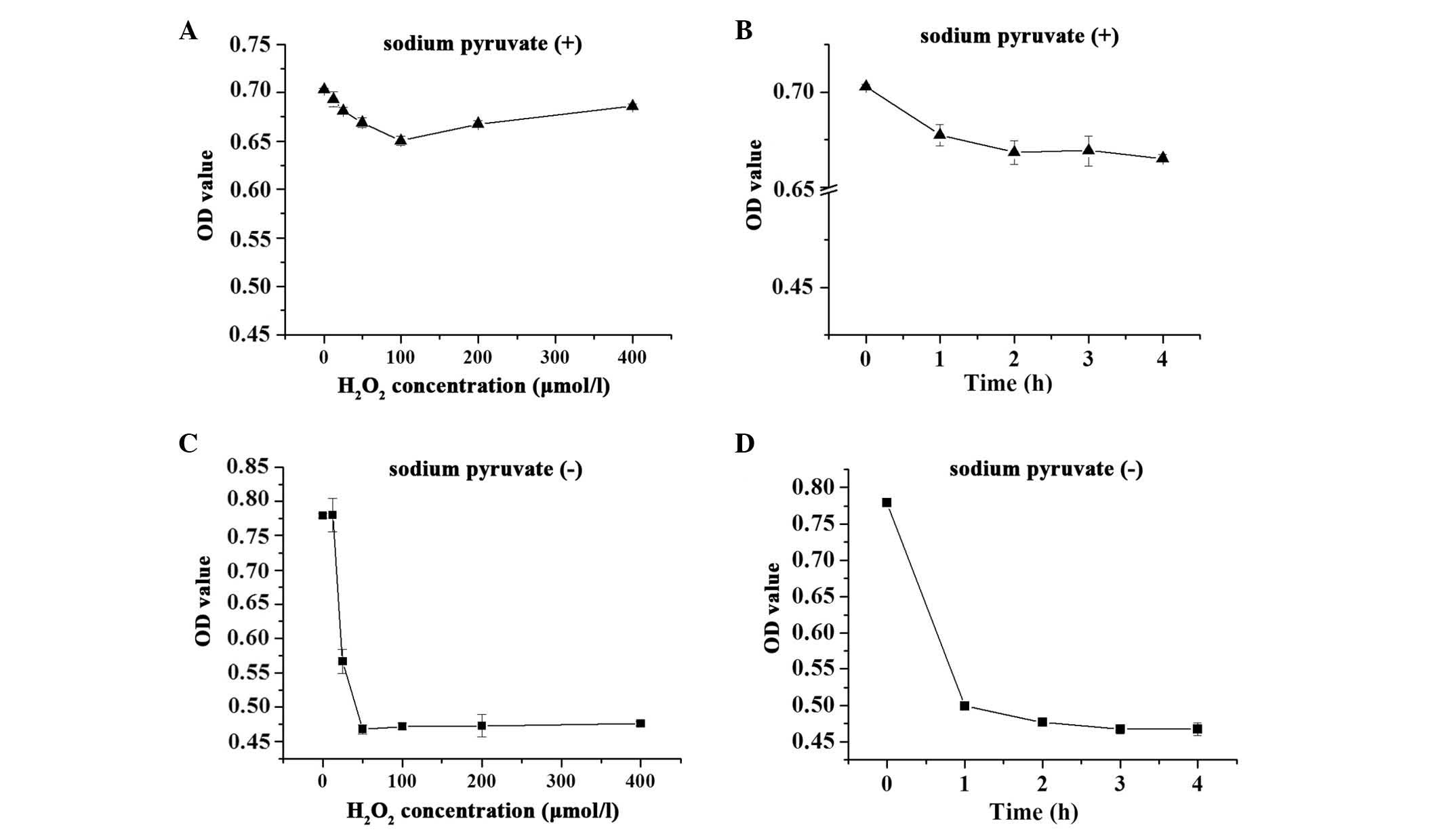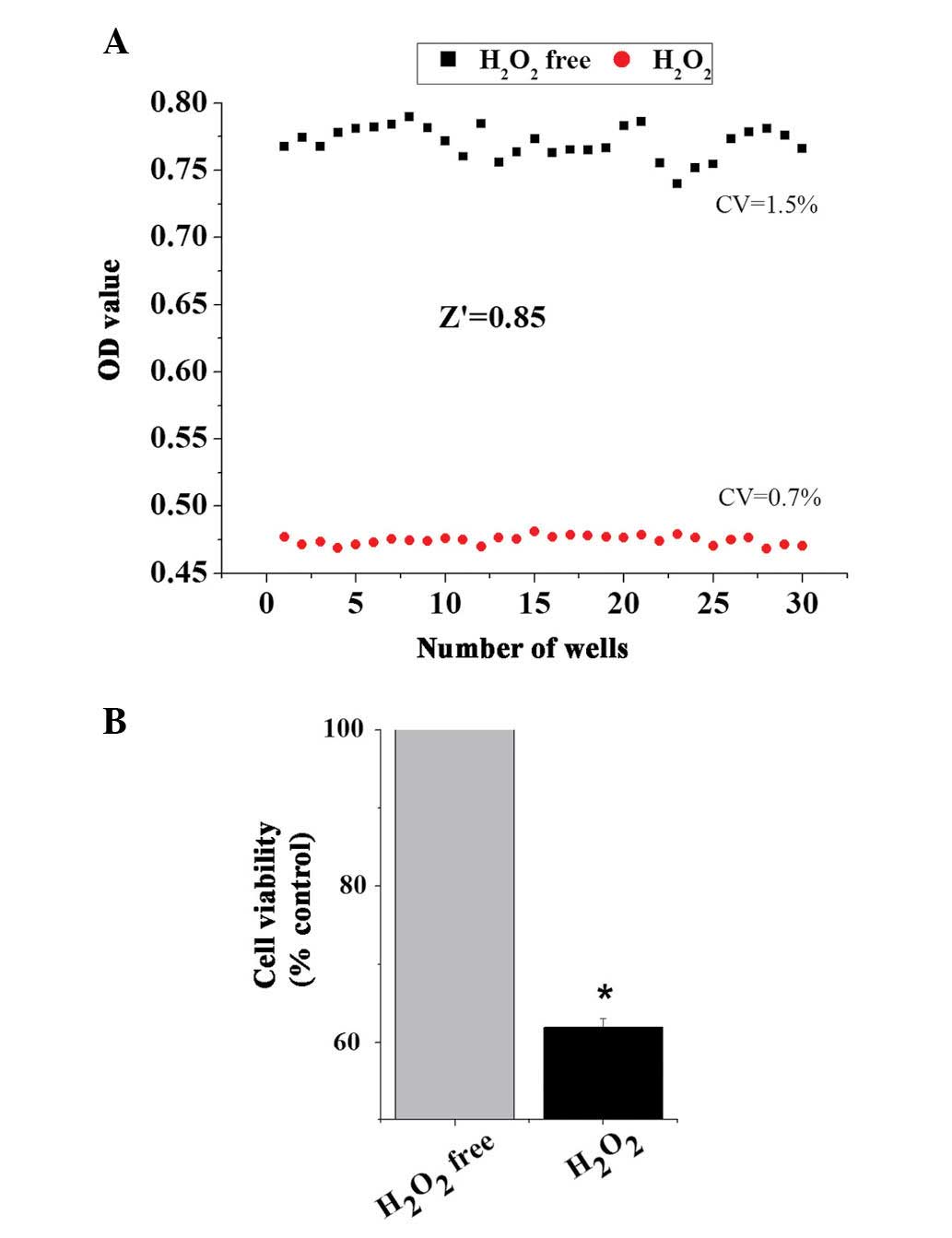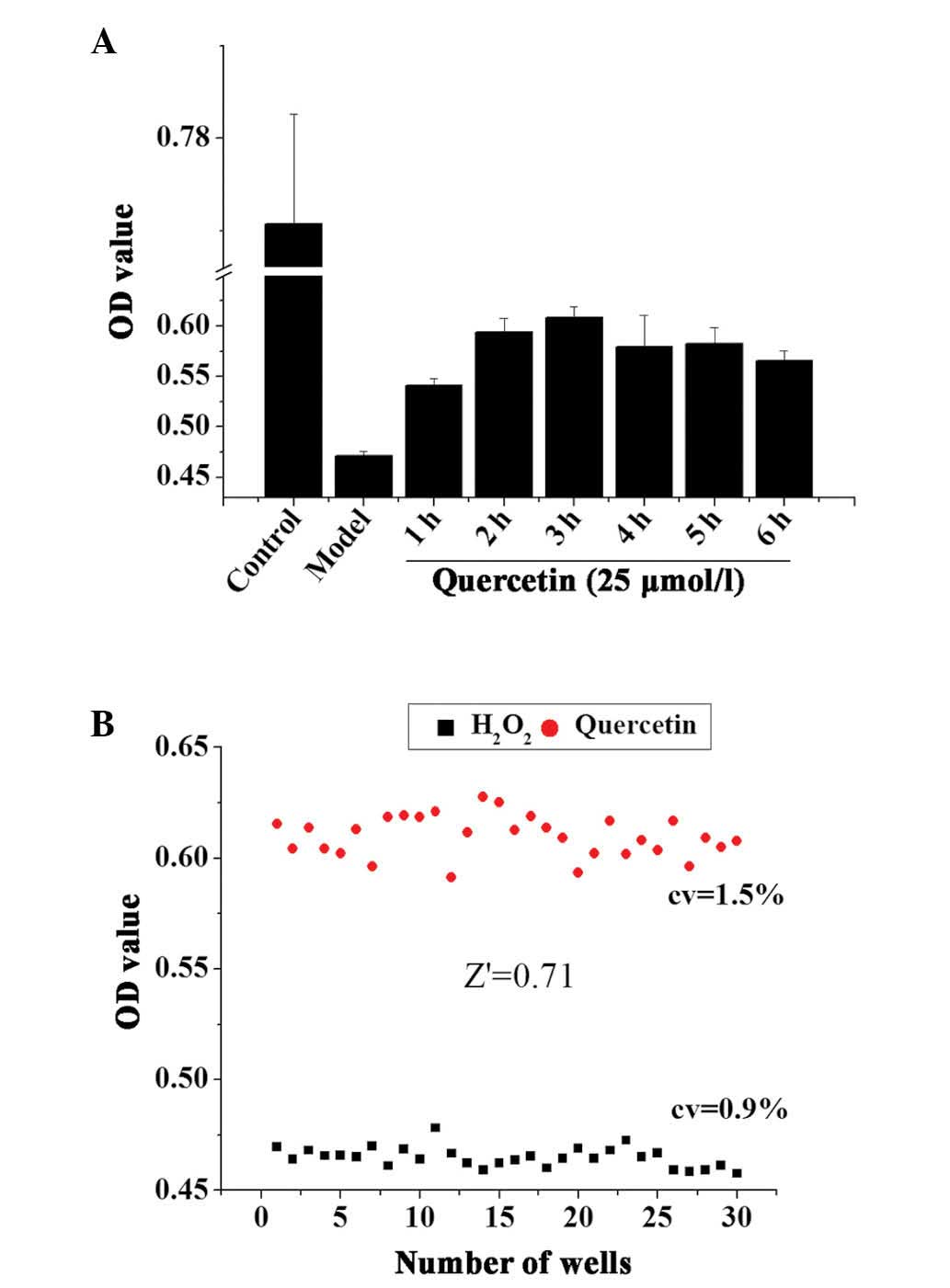|
1
|
Galli F, Piroddi M, Annetti C, Aisa C,
Floridi E and Floridi A: Oxidative stress and reactive oxygen
species. Contrib Nephrol. 149:240–260. 2005. View Article : Google Scholar : PubMed/NCBI
|
|
2
|
Pham-Huy LA, He H and Pham-Huy C: Free
radicals, antioxidants in disease and health. International journal
of biomedical science: Int J Biomed Sc. 4:89–96. 2008.
|
|
3
|
Geronikaki AA and Gavalas AM: Antioxidants
and inflammatory disease: Synthetic and natural antioxidants with
anti-inflammatory activity. Comb Chem High Throughput Screen.
9:425–442. 2006. View Article : Google Scholar : PubMed/NCBI
|
|
4
|
Guo RF and Ward PA: Role of oxidants in
lung injury during sepsis. Antioxid Redox Signal. 9:1991–2002.
2007. View Article : Google Scholar : PubMed/NCBI
|
|
5
|
Gilgun-Sherki Y, Melamed E and Offen D:
Oxidative stress induced-neurodegenerative diseases: The need for
antioxidants that penetrate the blood brain barrier.
Neuropharmacology. 40:959–975. 2001. View Article : Google Scholar : PubMed/NCBI
|
|
6
|
Kumar SV, Saritha G and Fareedullah M:
Role of antioxidants and oxidative stress in cardiovascular
diseases. Ann Biol Res. 3:158–175. 2010.
|
|
7
|
Venardos KM, Perkins A, Headrick J and
Kaye DM: Myocardial ischemia-reperfusion injury, antioxidant enzyme
systems, and selenium: A review. Cur Med Chem. 14:1539–1549. 2007.
View Article : Google Scholar
|
|
8
|
Zhao ZQ: Oxidative stress-elicited
myocardial apoptosis during reperfusion. Curr Opin Pharmacol.
4:159–165. 2004. View Article : Google Scholar : PubMed/NCBI
|
|
9
|
Saini HK, Machackova J and Dhalla NS: Role
of reactive oxygen species in ischemic preconditioning of
subcellular organelles in the heart. Antioxid Redox Signal.
6:393–404. 2004. View Article : Google Scholar : PubMed/NCBI
|
|
10
|
Zima AV and Blatter LA: Redox regulation
of cardiac calcium channels and transporters. Cardiovasc Res.
71:310–321. 2006. View Article : Google Scholar : PubMed/NCBI
|
|
11
|
Cesselli D, Jakoniuk I, Barlucchi L,
Beltrami AP, Hintze TH, Nadal-Ginard B, Kajstura J, Leri A and
Anversa P: Oxidative stress-mediated cardiac cell death is a major
determinant of ventricular dysfunction and failure in dog dilated
cardiomyopathy. Circ Res. 89:279–286. 2001. View Article : Google Scholar : PubMed/NCBI
|
|
12
|
Kwon SH, Pimentel DR, Remondino A, Sawyer
DB and Colucci WS: H2O2 regulates cardiac
myocyte phenotype via concentration-dependent activation of
distinct kinase pathways. J Mol Cell Cardiol. 35:615–621. 2003.
View Article : Google Scholar : PubMed/NCBI
|
|
13
|
Rayment NB, Haven AJ, Madden B, Murday A,
Trickey R, Shipley M, Davies MJ and Katz DR: Myocyte loss in
chronic heart failure. J Pathol. 188:213–219. 1999. View Article : Google Scholar : PubMed/NCBI
|
|
14
|
Giordano FJ: Oxygen, oxidative stress,
hypoxia, and heart failure. J Clin Invest. 115:500–508. 2005.
View Article : Google Scholar : PubMed/NCBI
|
|
15
|
Kimes BW and Brandt BL: Properties of a
clonal muscle cell line from rat heart. Exp Cell Res. 98:367–381.
1976. View Article : Google Scholar : PubMed/NCBI
|
|
16
|
Su CY, Chong KY, Edelstein K, Lille S,
Khardori R and Lai CC: Constitutive hsp70 attenuates hydrogen
peroxide-induced membrane lipid peroxidation. Biochem Biophys Res
Commun. 265:279–284. 1999. View Article : Google Scholar : PubMed/NCBI
|
|
17
|
Park ES, Kang JC, Kang DH, Jang YC, Yi KY,
Chung HJ, Park JS, Kim B, Feng ZP and Shin HS: 5-AIQ inhibits
H2O2-induced apoptosis through reactive
oxygen species scavenging and Akt/GSK-3β signaling pathway in H9c2
cardiomyocytes. Toxicol Appl Pharmacol. 268:90–98. 2013. View Article : Google Scholar : PubMed/NCBI
|
|
18
|
Aggeli IK, Gaitanaki C and Beis I:
Involvement of JNKs and p38-MAPK/MSK1 pathways in
H2O2-induced upregulation of heme oxygenase-1
mRNA in H9c2 cells. Cell Signal. 18:1801–1812. 2006. View Article : Google Scholar : PubMed/NCBI
|
|
19
|
Tanaka H, Sakurai K, Takahashi K and
Fujimoto Y: Requirement of intracellular free thiols for hydrogen
peroxide-induced hypertrophy in cardiomyocytes. J Cell Biochem.
89:944–955. 2003. View Article : Google Scholar : PubMed/NCBI
|
|
20
|
Qu S, Zhu H, Wei X, Zhang C, Jiang L, Liu
Y, Luo Q and Xiao X: Oxidative stress-mediated up-regulation of
myocardial ischemic preconditioning up-regulated protein 1 gene
expression in H9c2 cardiomyocytes is regulated by cyclic
AMP-response element binding protein. Radic Biol Med. 49:580–586.
2010. View Article : Google Scholar
|
|
21
|
Law CH, Li JM, Chou HC, Chen YH and Chan
HL: Hyaluronic acid-dependent protection in H9C2 cardiomyocytes: A
cell model of heart ischemia-reperfusion injury and treatment.
Toxicology. 303:54–71. 2013. View Article : Google Scholar
|
|
22
|
Diestel A, Drescher C, Miera O, Berger F
and Schmitt KR: Hypothermia protects H9c2 cardiomyocytes from
H2O2 induced apoptosis. Cryobiology.
62:53–61. 2011. View Article : Google Scholar
|
|
23
|
Eguchi M, Liu Y, Shin EJ and Sweeney G:
Leptin protects H9c2 rat cardiomyocytes from
H2O2-induced apoptosis. FEBS J.
275:3136–3144. 2008. View Article : Google Scholar : PubMed/NCBI
|
|
24
|
Park ES, Kang JC, Jang YC, Park JS, Jang
SY, Kim DE, Kim B and Shin HS: Cardioprotective effects of
rhamnetin in H9c2 cardiomyoblast cells under
H2O2-induced apoptosis. J Ethnopharmacol.
153:552–560. 2014. View Article : Google Scholar : PubMed/NCBI
|
|
25
|
Zhang JH, Chung TD and Oldenburg KR: A
simple statistical parameter for use in evaluation and validation
of high throughput screening assays. J Biomol Screen. 4:67–73.
1999. View Article : Google Scholar
|
|
26
|
Aggeli IK, Beis I and Gaitanaki C: ERKs
and JNKs mediate hydrogen peroxide-induced Egr-1 expression and
nuclear accumulation in H9c2 cells. Physiol Res. 59:443–454.
2010.
|
|
27
|
Ryter SW, Kim HP, Hoetzel A, Park JW,
Nakahira K, Wang X and Choi AM: Mechanisms of cell death in
oxidative stress. Antioxid Redox Signal. 9:49–89. 2007. View Article : Google Scholar
|
|
28
|
Clerk A, Michael A and Sugden PH:
Stimulation of multiple mitogen-activated protein kinase
sub-families by oxidative stress and phosphorylation of the small
heat shock protein, HSP25/27, in neonatal ventricular myocytes.
Biochem J. 333:581–589. 1998. View Article : Google Scholar : PubMed/NCBI
|
|
29
|
Di Meo S, Venditti P and De Leo T: Tissue
protection against oxidative stress. Experientia. 52:786–794. 1996.
View Article : Google Scholar : PubMed/NCBI
|
|
30
|
Bogoyevitch MA: Signalling via
stress-activated mitogen-activated protein kinases in the
cardiovascular system. Cardiovasc Res. 45:826–842. 2000. View Article : Google Scholar : PubMed/NCBI
|
|
31
|
Ravingerová T, Barancík M and Strnisková
M: Mitogen-activated protein kinases: A new therapeutic target in
cardiac pathology. Mol Cell Biochem. 247:127–138. 2003. View Article : Google Scholar : PubMed/NCBI
|
|
32
|
Wang Y: Mitogen-activated protein kinases
in heart development and diseases. Circulation. 116:1413–1423.
2007. View Article : Google Scholar : PubMed/NCBI
|
|
33
|
Gao Z, Huang K and Xu H: Protective
effects of flavonoids in the roots of Scutellaria baicalensis
Georgi against hydrogen peroxide-induced oxidative stress in
HS-SY5Y cells. Pharmacol Res. 43:173–178. 2001. View Article : Google Scholar : PubMed/NCBI
|
|
34
|
Park C, So HS, Shin CH, Baek SH, Moon BS,
Shin SH, Lee HS, Lee DW and Park R: Quercetin protects the hydrogen
peroxide-induced apoptosis via inhibition of mitochondrial
dysfunction in H9c2 cardiomyoblast cells. Biochem Pharmacol.
66:1287–1295. 2003. View Article : Google Scholar : PubMed/NCBI
|
|
35
|
Anestopoulos I, Kavo A, Tentes I,
Kortsaris A, Panayiotidis M, Lazou A and Pappa A: Silibinin
protects H9c2 cardiac cells from oxidative stress and inhibits
phenylephrine-induced hypertrophy: Potential mechanisms. J Nutr
Biochem. 24:586–594. 2013. View Article : Google Scholar
|
|
36
|
Maiwulanjiang M, Chen J, Xin G, Gong AG,
Miernisha A, Du CY, Lau KM, Lee PS, Chen J, Dong TT, et al: The
volatile oil of Nardostachyos Radix et Rhizoma inhibits the
oxidative stress-induced cell injury via reactive oxygen species
scavenging and Akt activation in H9c2 cardiomyocyte. J
Ethnopharmacol. 153:491–498. 2014. View Article : Google Scholar : PubMed/NCBI
|
|
37
|
Chen B, Mao R, Wang H and She JX: Cell
line and drug-dependent effect of ERBB3 on cancer cell
proliferation, chemosensitivity, and multidrug actions. Int J High
Throughput Screen. 1:49–55. 2010.
|
|
38
|
Li H, Deng Z, Liu R, Loewen S and Tsao R:
Carotenoid compositions of coloured tomato cultivars and
contribution to antioxidant activities and protection against
H2O2-induced cell death in H9c2. Food Chem.
136:878–888. 2013. View Article : Google Scholar
|
|
39
|
Woo SM, Min KJ, Kim S, Park JW, Kim DE,
Chun KS, Kim YH, Lee TJ, Kim SH, Choi YH, et al: Silibinin induces
apoptosis of HT29 colon carcinoma cells through early growth
response-1 (EGR-1)-mediated non-steroidal anti-inflammatory
drug-activated gene-1 (NAG-1) up-regulation. Chem Biol Interact.
211:36–43. 2014. View Article : Google Scholar : PubMed/NCBI
|
|
40
|
O'Donnell-Tormey J, Nathan CF, Lanks K,
DeBoer CJ and de la Harpe J: Secretion of pyruvate. An antioxidant
defense of mammalian cells. J Exp Med. 165:500–514. 1987.
View Article : Google Scholar : PubMed/NCBI
|
|
41
|
Holleman AF: Notice sur l'action de l'eau
oxygénée sur les acides α-cétoniques et sur les dicétones 1. 2.
Recl Trav Chim Pays-Bas Belg. 23:169–172. 1904.In French.
View Article : Google Scholar
|
|
42
|
Dorn GW II: Apoptotic and non-apoptotic
programmed cardiomyocyte death in ventricular remodelling.
Cardiovasc Res. 81:465–473. 2009. View Article : Google Scholar :
|
|
43
|
Shih PH, Yeh CT and Yen GC: Anthocyanins
induce the activation of phase II enzymes through the antioxidant
response element pathway against oxidative stress-induced
apoptosis. J Agric Food Chem. 55:9427–9435. 2007. View Article : Google Scholar : PubMed/NCBI
|
|
44
|
Sukhatme VP, Cao XM, Chang LC, Tsai-Morris
CH, Stamenkovich D, Ferreira PC, Cohen DR, Edwards SA, Shows TB,
Curran T, et al: A zinc finger-encoding gene coregulated with c-fos
during growth and differentiation, and after cellular
depolarization. Cell. 53:37–43. 1988. View Article : Google Scholar : PubMed/NCBI
|
|
45
|
Yan SF, Fujita T, Lu J, Okada K, Shan Zou
Y, Mackman N, Pinsky DJ and Stern DM: Egr-1, a master switch
coordinating upregulation of divergent gene families underlying
ischemic stress. Nat Med. 6:1355–1361. 2000. View Article : Google Scholar : PubMed/NCBI
|
|
46
|
Gaggioli C, Deckert M, Robert G, Abbe P,
Batoz M, Ehrengruber MU, Ortonne JP, Ballotti R and Tartare-Deckert
S: HGF induces fibronectin matrix synthesis in melanoma cells
through MAP kinase-dependent signaling pathway and induction of
Egr-1. Oncogene. 24:1423–1433. 2005. View Article : Google Scholar
|
|
47
|
Guha M, O'Connell MA, Pawlinski R, Hollis
A, McGovern P, Yan SF, Stern D and Mackman N: Lipopolysaccharide
activation of the MEK-ERK1/2 pathway in human monocytic cells
mediates tissue factor and tumor necrosis factor alpha expression
by inducing Elk-1 phosphorylation and Egr-1 expression. Blood.
98:1429–1439. 2001. View Article : Google Scholar : PubMed/NCBI
|
|
48
|
Hjoberg J, Le L, Imrich A, Subramaniam V,
Mathew SI, Vallone J, Haley KJ, Green FH, Shore SA and Silverman
ES: Induction of early growth-response factor 1 by platelet-derived
growth factor in human airway smooth muscle. Am J Physiol Lung Cell
Mol Physiol. 286:L817–L825. 2004. View Article : Google Scholar : PubMed/NCBI
|
|
49
|
Li CJ, Ning W, Matthay MA,
Feghali-Bostwick CA and Choi AM: MAPK pathway mediates
EGR-1-HSP70-dependent cigarette smoke-induced chemokine production.
Am J Physiol Lung Cell Mol Physiol. 292:L1297–L1303. 2007.
View Article : Google Scholar : PubMed/NCBI
|
|
50
|
Kaufmann K and Thiel G: Epidermal growth
factor and thrombin induced proliferation of immortalized human
keratinocytes is coupled to the synthesis of Egr-1, a zinc finger
transcriptional regulator. J Cell Biochem. 85:381–391. 2002.
View Article : Google Scholar : PubMed/NCBI
|
|
51
|
Rössler OG and Thiel G: Thrombin induces
Egr-1 expression in fibroblasts involving elevation of the
intracellular Ca2+ concentration, phosphorylation of ERK
and activation of ternary complex factor. Mol Biol. 10:402009.
|
|
52
|
Lohoff M, Giaisi M, Köhler R, Casper B,
Krammer PH and Li-Weber M: Early growth response protein-1 (Egr-1)
is preferentially expressed in T helper type 2 (Th2) cells and is
involved in acute transcription of the Th2 cytokine interleukin-4.
J Biol Chem. 285:1643–1652. 2010. View Article : Google Scholar :
|
|
53
|
Gashler A and Sukhatme VP: Early growth
response protein 1 (Egr-1): Prototype of a zinc-finger family of
transcription factors. Prog Nucleic Acid Res Mol Biol. 50:191–224.
1995. View Article : Google Scholar : PubMed/NCBI
|
|
54
|
Liu C, Rangnekar VM, Adamson E and Mercola
D: Suppression of growth and transformation and induction of
apoptosis by EGR-1. Cancer Gene Ther. 5:3–28. 1998.PubMed/NCBI
|
|
55
|
Thiel G and Cibelli G: Regulation of life
and death by the zinc finger transcription factor Egr-1. J Cell
Physiol. 193:287–292. 2002. View Article : Google Scholar : PubMed/NCBI
|
|
56
|
Bhindi R, Fahmy RG, McMahon AC, Khachigian
LM and Lowe HC: Intracoronary delivery of DNAzymes targeting human
EGR-1 reduces infarct size following myocardial ischaemia
reperfusion. J Pathol. 227:157–164. 2012. View Article : Google Scholar : PubMed/NCBI
|
|
57
|
Kasneci A, Kemeny-Suss NM, Komarova SV and
Chalifour LE: Egr-1 negatively regulates calsequestrin expression
and calcium dynamics in ventricular cells. Cardiovasc Res.
1:695–702. 2009.
|
|
58
|
Zins K, Pomyje J, Hofer E, Abraham D,
Lucas T and Aharinejad S: Egr-1 upregulates Siva-1 expression and
induces cardiac fibroblast apoptosis. Int J Mol Sci. 15:1538–1553.
2014. View Article : Google Scholar : PubMed/NCBI
|
|
59
|
Aebert H, Cornelius T, Ehr T, Holmer SR,
Birnbaum DE, Riegger GA and Schunkert H: Expression of immediate
early genes after cardioplegic arrest and reperfusion. Ann Thorac
Surg. 63:1669–1675. 1997. View Article : Google Scholar : PubMed/NCBI
|
|
60
|
Chen CA, Chen TS and Chen HC:
Extracellular signal-regulated kinase plays a proapoptotic role in
podocytes after reactive oxygen species treatment and inhibition of
integrin-extracellular matrix interaction. Exp Biol Med (Maywood).
237:777–783. 2012. View Article : Google Scholar
|
|
61
|
Hartney T, Birari R, Venkataraman S,
Villegas L, Martinez M, Black SM, Stenmark KR and Nozik-Grayck E:
Xanthine oxidase-derived ROS upregulate Egr-1 via ERK1/2 in PA
smooth muscle cells; model to test impact of extracellular ROS in
chronic hypoxia. PLoS One. 6:e275312011. View Article : Google Scholar : PubMed/NCBI
|
|
62
|
Iyoda T, Zhang F, Sun L, Hao F,
Schmitz-Peiffer C, Xu X and Cui MZ: Lysophosphatidic acid induces
early growth response-1 (Egr-1) protein expression via protein
kinase Cδ-regulated extracellular signal-regulated kinase (ERK) and
c-Jun N-terminal kinase (JNK) activation in vascular smooth muscle
cells. J Biol Chem. 287:22635–22642. 2012. View Article : Google Scholar : PubMed/NCBI
|
|
63
|
Wang C, Dostanic S, Servant N and
Chalifour LE: Egr-1 negatively regulates expression of the
sodium-calcium exchanger-1 in cardiomyocytes in vitro and in vivo.
Cardiovasc Res. 65:187–194. 2005. View Article : Google Scholar
|




















